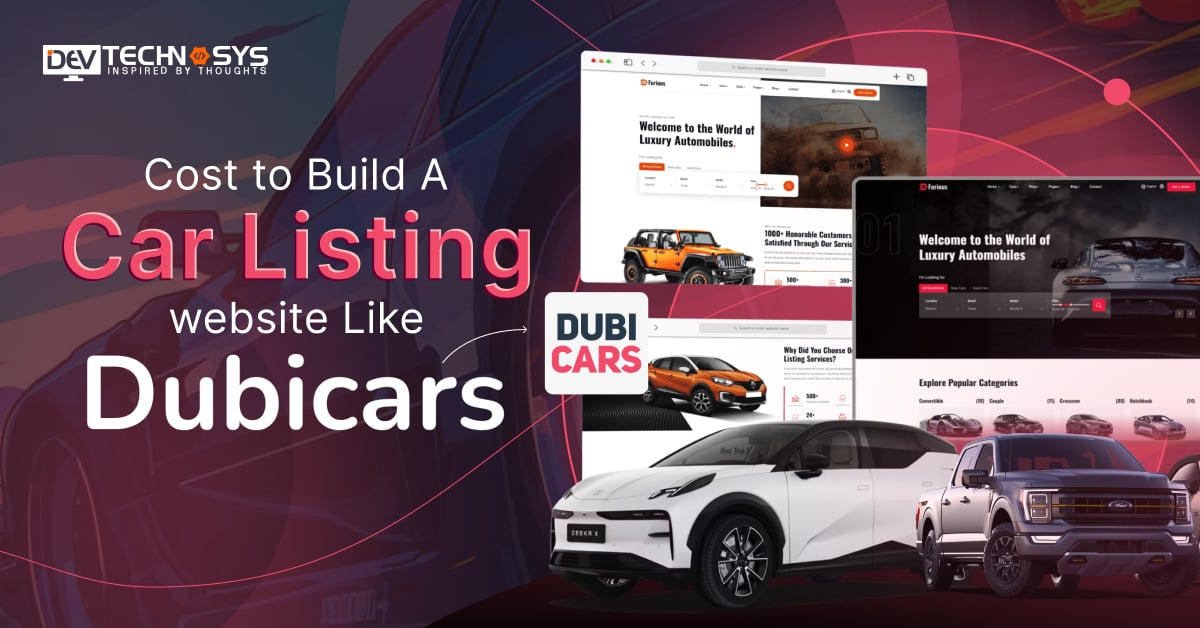Do you want to launch a very big project? But you are doubtful whether this product will do well in the market or not? Then why not use MVP? It means launching a product that has limited or basic features and does not cost much to build. That is why the demand for MVP(Minimum Viable Product) is increasing, and most businesses use MVP before launching the exact product to make changes according to market analysis.
Are you looking to know the exact cost to build an MVP? If yes. Then you landed on the right destination.
Just read this blog step-by-step to understand the overall MVP development cost, factors that affect the cost, and how it can reduce the cost.
Stay Tuned!
What is MVP?
An MVP, or Minimum Viable Product, is the simplest version of a product that only includes the elements required to satisfy early consumers and validate an idea. It enables developers to deploy rapidly, receive user input, and make data-driven enhancements before committing substantially to full-scale development. MVPs assist to decrease risk, save money, and confirm that the product idea matches with actual user needs and market demand.
- Basic User Management
- Analytics & Feedback
- User Authentication
How Much Does it Cost to Build an MVP?
The cost to build an MVP typically ranges from $8,000 to $25,000, depending on complexity, features, technology stack, and the development team’s location. A simple MVP with core features may cost less, while more complex products with custom UI, integrations, or advanced functionality cost more. Hiring freelancers is cheaper, while agencies offer comprehensive support at a higher price. Prioritizing core features and using open-source tools or no-code platforms can help reduce costs. So, here we provide the MVP cost estimation guide:
| MVP Complexity | Freelancers | Small Agency | Top-tier Agency | Timeline | Includes |
| Basic | $8,000 – $12,000 | $10,000 – $13,000 | $12,000 – $17,000 | 3 – 6 weeks | Core feature, basic UI, simple backend, basic auth |
| Moderate | $15,000 – $20,000 | $14,000 – $18,000 | $17,000 – $20,000 | 6 – 10 weeks | Multiple features, custom UI, database, analytics |
| Complex | $20,000 – $30,000+ | $20,000 – $24,000+ | $20,000 – $30,000+ | 10 – 14+ weeks | Scalable backend, API integrations, admin panel, security |
Key Factors Influencing MVP Development Cost
Here’s a detailed breakdown of the key factors influencing MVP development cost, with cost estimates mentioned in advanced tables. These are estimates based on industry averages, and actual costs may vary depending on factors affecting MVP development costs.
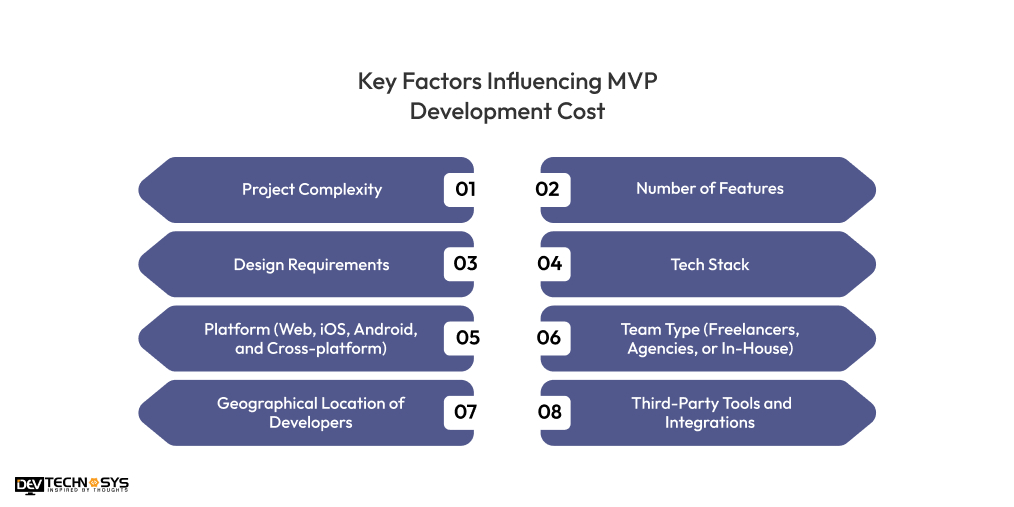
1. Project Complexity
Complex MVPs with sophisticated features, various integrations, and advanced functionalities necessitate additional time and specialized skills, which raises development costs. Higher complexity requires more unique code, testing, and debugging, resulting in a lengthier and more expensive process.
| Complexity Level | Description | Estimated Cost Range |
| Low Complexity | Simple MVP with basic features (e.g., a landing page or a single-function app). | $8,000 – $12,000
|
| Medium Complexity | Moderate features with some custom functionalities, integrations, and moderate design complexity. | $13,000 – $20,000
|
| High Complexity | Advanced features, multiple integrations, custom backend, complex user roles, and unique design. | $20,000 – $25,000+
|
2. Number of Features
The more features an MVP has, the higher the price. Each new feature necessitates design, development, and testing, which extends the project duration and resources required, directly affecting the entire mobile application development cost.
| Number of Features | Description | Estimated Cost Range |
| 1-3 Features | Core MVP features (e.g., authentication, basic user profile, search functionality). | $5,000 – $10,000
|
| 4-6 Features | Intermediate features, such as additional functionality and integrations (e.g., notifications, chat). | $10,000 – $15,000
|
| 7+ Features | Full-featured MVP with multiple user roles, advanced functionality, and complex interactions. | $15,000 – $18,000+
|
3. Design Requirements
Custom and complex designs, such as one-of-a-kind user interfaces, animations, or distinctive branding, raise prices. The more intricate the design, the more specialist design work, prototyping, and revisions are required, which increases average MVP development cost.
| Design Complexity | Description | Estimated Cost Range |
| Basic Design | Pre-designed templates or simple UI/UX (standard layouts with minimal custom branding). | $2,000 – $5,000
|
| Custom Design | Tailored UI/UX with unique branding, interactive elements, and minor customizations. | $5,000 – $10,000
|
| Advanced Design | High-end UI/UX design with animations, custom graphics, and unique interactions. | $12,000 – $17,000+
|
4. Tech Stack
The choice of programming languages, frameworks, and tools has a substantial impact on cost. Emerging technologies or more specialized tech stacks may necessitate qualified engineers and a lengthier development period, raising the overall MVP development services cost.
| Technology Type | Description | Estimated Cost Range |
| Standard Tech (e.g., PHP, HTML, CSS) | Traditional, widely used technology stacks like LAMP. | $5,000 – $8,000
|
| Modern Tech (e.g., React, Node.js) | Popular and modern tech stacks requiring skilled developers (e.g., MERN, MEAN). | $8,000 – $10,000
|
| Emerging Tech (e.g., Blockchain, AI) | Advanced or specialized technologies with a smaller pool of developers require more time and expertise. | $10,000 – $15,000+
|
5. Platform (Web, iOS, Android, and Cross-platform)
Developing for several platforms (iOS, Android, and Web) necessitates distinct codebases, increasing costs owing to additional development and testing. Cross-platform development tools can save money, but they may limit functionality or performance.
| Platform Type | Description | Estimated Cost Range |
| Single Platform (Web or Mobile) | Developing for one platform, either Web, iOS, or Android. | $5,000 – $12,000
|
| Multiple Platforms (iOS + Android) | Native development for separate platforms, requiring individual codebases for each. | $12,000 – $17,000
|
| Cross-Platform (e.g., React Native) | One codebase for multiple platforms, often reducing cost but potentially limiting performance. | $18,000 – $22,000+
|
6. Team Type (Freelancers, Agencies, or In-House)
Freelancers are typically less expensive but may lack resources, whereas agencies provide more comprehensive services at a greater cost. In-house teams might be costly owing to recruiting and overhead, but they provide long-term management and cooperation on projects.
| Team Type | Description | Estimated Cost Range |
| Freelancers | Independent developers or designers hired for specific tasks. | $20 – $100/hour (Freelancer rates vary by expertise and region)
|
| Agencies | Full-service development teams offering a range of services (design, development, project management). | $50 – $150/hour
|
| In-house | Full-time employees working within the company. Requires overhead, salaries, and recruitment costs. | $20,000 – $25,000/year per employee (for in-house salaries, excluding recruitment and overhead)
|
7 Geographical Location of Developers
Developer rates vary by geography. Developers in North America and Western Europe often charge more than those in Eastern Europe or Asia. Geographic differences have an impact on both the cost structure and the overall Android app development budget.
| Location | Description | Estimated Cost Range |
| Low-Cost Regions (e.g., India, Ukraine) | Developers in countries with lower living costs generally offer more affordable rates. | $10 – $50/hour
|
| Medium-Cost Regions (e.g., Latin America, Southeast Asia) | Developers from moderately priced countries with a balance between cost and quality. | $25 – $75/hour
|
| High-Cost Regions (e.g., USA, Western Europe) | Developers in high-cost countries, such as the U.S. or Western Europe, where rates are significantly higher. | $100 – $250/hour
|
8. Third-Party Tools and Integrations
Integrating third-party tools or APIs (such as payment gateways, CRM systems, or authentication services) requires additional development effort and may incur license expenses. The intricacy of these connections has an influence on the MVP project’s timeframe and expense.
| Tool/Integration Type | Description | Estimated Cost Range |
| Basic Integrations (e.g., Payment Gateways, Social Media Logins) | Simple integrations requiring minimal custom development. | $1,000 – $5,000
|
| Advanced Integrations (e.g., CRM, ERP, Marketing Tools) | Complex integrations with tools like CRMs, advanced analytics, or third-party services. | $5,000 – $10,000
|
| Custom Tool Development
|
Creating custom APIs, tools, or backend systems for specialized functions. | $10,000 – $20,000+
|
Summary of Total MVP Development Cost Estimates
| Factor | Low Complexity | Medium Complexity | High Complexity |
| Estimated MVP Cost | $5,000 – $10,000 | $15,000 – $20,000 | $20,000 – $25,000+ |
| Design | $2,000 – $5,000 | $5,000 – $10,000 | $10,000 – $15,000+ |
| Development Time | 1-3 months | 3-6 months | 6+ months |
| Platform | $5,000 – $10,000 | $10,000 – $16,000 | $16,000 – $20,000 |
| Technology Stack | $5,000 – $8,000 | $8,000 – $15,000 | $15,000 – $18,000+ |
| Team | $20 – $25/hr | $25 – $50/hr | $50 – $100/hr |
How to Reduce the Cost to Develop an MVP?
Reducing the cost to develop a Minimum Viable Product (MVP) involves smart budget planning for MVP development, strategic choices, and efficient use of resources. Here are proven methods to cost breakdown of MVP development:
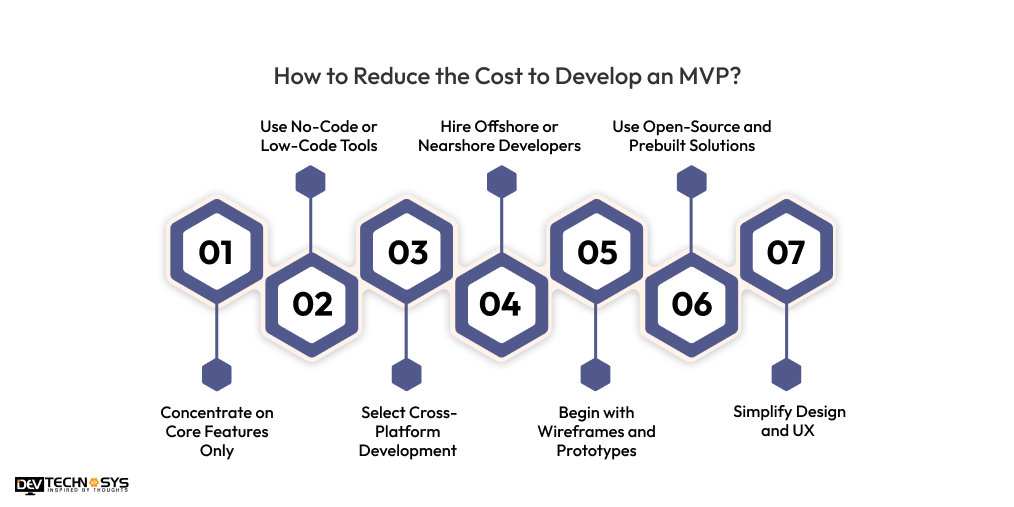
1. Concentrate on Core Features Only
Prioritize the most important features that directly respond to user demands. Avoid introducing nice-to-have features in the initial release. This enables speedier development, reduces complexity, and lowers the minimum viable product cost. Use early customer input to evaluate the fundamental concept before increasing functionality.
2. Use No-Code or Low-Code Tools
Low-code and no-code platforms such as Bubble, Glide, and Webflow make MVP creation possible without requiring much programming. These solutions significantly cut development time and cost by including drag-and-drop capabilities and prebuilt components, making them suitable for swiftly testing and launching new concepts with low technical commitment.
3. Select Cross-Platform Development
Frameworks such as React Native or Flutter enable developers to create a single program that runs on both iOS and Android. This eliminates the need for separate native codebases, dramatically reducing MVP app development cost while maintaining a functioning mobile experience across platforms via shared resources.
4. Hire Offshore or Nearshore Developers
Hire developers from countries with cheaper hourly rates, such as India, Ukraine, or the Philippines, can help to cut MVP development expenses while maintaining quality. Ensure that suitable communication and project management systems are in place to ensure productivity and product quality while benefiting from global cost savings.
5. Begin with Wireframes and Prototypes
Before you start coding, utilize tools like Figma or Adobe XD to generate interactive wireframes or mockups. This simplifies requirements, improves developer communication, and lowers the need for costly redesigns. Visually validating concepts also allows for early user response without investing much in MVP development process.
6. Use Open-Source and Prebuilt Solutions
Use open-source libraries, frameworks, and third-party APIs instead of creating functionality from scratch. Firebase for backend and Stripe for payments minimize development time and costs. According to the blockchain MVP development company, prebuilt components and community-maintained solutions save time and increase dependability.
7. Simplify Design and UX
In the MVP, avoid using unique animations, complicated interfaces, or elaborate visual effects. A minimal, clean design increases usability while lowering design and front-end development expenses. Prioritize utility above aesthetics at first, then refine the user interface once the product-market fit is verified.
What Are the Hidden Cost to Create an MVP?
Hidden costs in MVP development include rework from unclear requirements, third-party service and API fees, ongoing maintenance post-launch, project management time, and quality assurance expenses. These often go unnoticed initially but can significantly impact the total MVP software development cost.
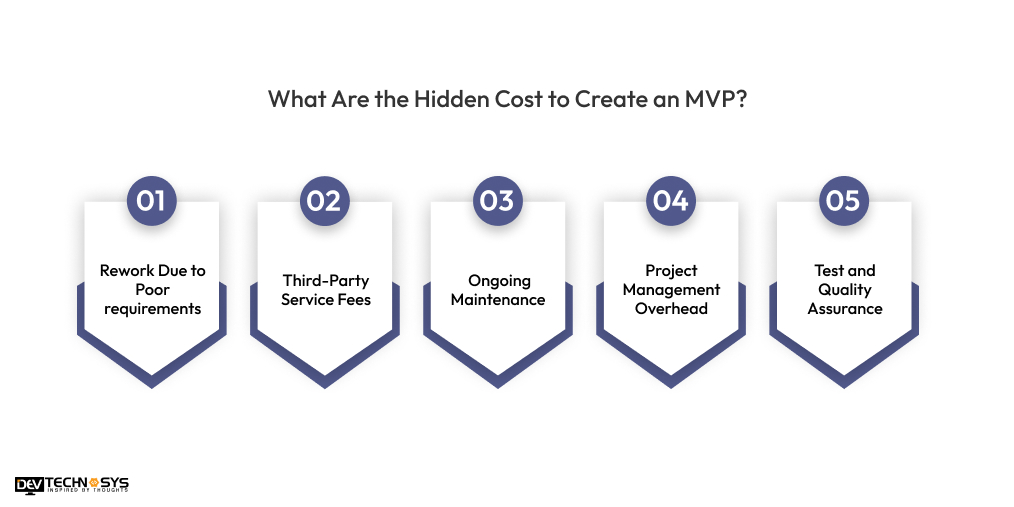
1. Rework Due to Poor requirements
Vague or shifting criteria might result in substantial rework. Clarifying scope early in the development process saves time and money by avoiding mismatched expectations, misunderstanding, and ambiguous user stories.
2. Third-Party Service Fees
APIs, cloud services, and analytics tools frequently require monthly or usage-based fees. While integration may be straightforward, recurrent charges can quickly accrue and have a long-term impact on your AI development budget.
3. Ongoing Maintenance
Any MVP should include post-launch bug patches, upgrades, and performance improvements. These continuing technological improvements frequently necessitate continual developer engagement and are rarely included in the initial MVP development cost for startups.
4. Project Management Overhead
Time spent coordinating, organizing, and attending meetings adds up. Project monitoring, whether conducted by a product owner or a professional manager, requires time and money that is sometimes not properly accounted for in development expenses.
5. Test and Quality Assurance
Proper QA necessitates time, tools, and maybe dedicated testers. Relying only on developers can lead to undetected errors and technological debt, which raises long-term expenses owing to poor user experience and low dependability.
Real-World Use Cases of Minimum Viable Product
These MVPs all started with a lean approach, focusing on core value, testing with early users, and evolving based on feedback. Here are real-world use cases of Minimum Viable Products (MVPs) that highlight how major companies started small, validated ideas, and scaled successfully:
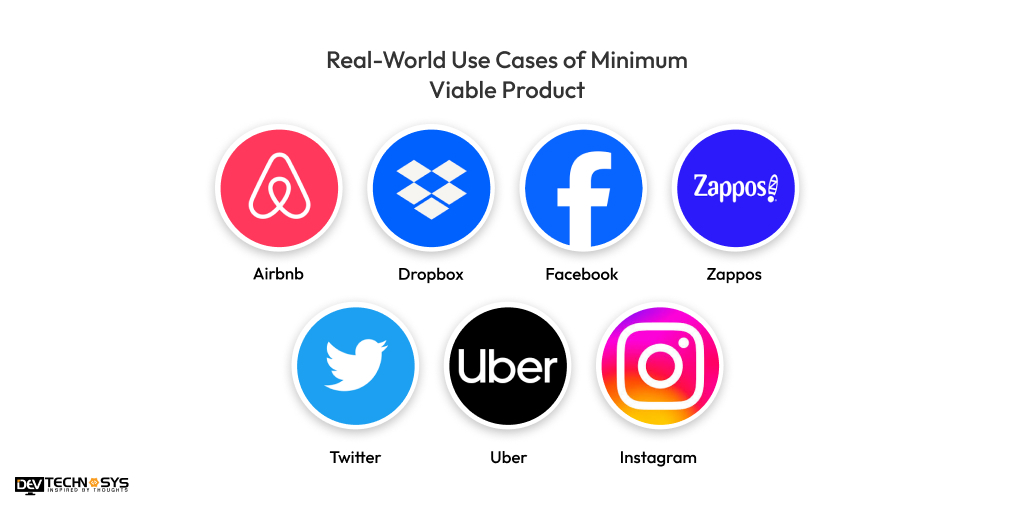
1. Airbnb
Use Case: Renting out space in their own apartment
MVP Strategy: The founders created a simple website to rent out air mattresses in their living room during a conference.
Outcome: Validated demand for short-term rentals, leading to the global Airbnb platform we know today.
2. Dropbox
Use Case: Cloud file storage and sharing
MVP Strategy: Dropbox launched with a demo video showing how the product would work, before building the full product.
Outcome: The video attracted thousands of early adopters and helped validate user interest before development.
3. Facebook
Use Case: Social networking for college students
MVP Strategy: Originally launched as “TheFacebook” for Harvard students only, with basic features like profiles and friend requests.
Outcome: Rapid adoption led to expansion across universities and eventually to the global social platform.
4. Zappos
Use Case: Online shoe sales
MVP Strategy: The founder photographed shoes from local stores and listed them online, only buying them once a customer placed an order.
Outcome: Validated that people were willing to buy shoes online, leading to a billion-dollar business.
5. Twitter
Use Case: Microblogging platform
MVP Strategy: Created as an internal tool for Odeo employees to share status updates, using SMS-based communication.
Outcome: Grew rapidly as users enjoyed short, real-time updates, evolving into a major social media platform.
6. Uber
Use Case: Ride-hailing service
MVP Strategy: Initially called “UberCab,” it only worked in San Francisco and allowed users to book black cars via SMS or a simple app.
Outcome: Positive feedback and high demand led to app development and global rollout.
7. Instagram
Use Case: Photo sharing
MVP Strategy: Launched with a single feature—photo sharing with filters—called Burbn.
Outcome: Focus on core functionality helped it grow quickly, leading to acquisition by Facebook.
Conclusion
In conclusion, developing an MVP is a critical step in bringing an idea to life while minimizing risk and cost. By focusing on core features, leveraging efficient tools, and choosing the right development strategy, you can keep your MVP development costs manageable.
Whether you choose to work with freelancers, agencies, or an MVP development company, it’s important to balance cost with quality. A reliable MVP development company can help you navigate these decisions, ensuring a successful launch while optimizing your budget and resources for future growth.
Frequently Asked Questions
1. How Much Does it Cost to Develop an MVP?
The cost to build an MVP varies based on project complexity, features, design, technology stack, and the development team. A typical MVP can cost anywhere from $8,000 to $25,000+.
2. Why Should I Create an MVP?
Creating an MVP allows you to test your product idea with minimal resources, gather user feedback, validate assumptions, and reduce risk before investing heavily in development, ultimately saving time and money while ensuring product-market fit.
3. How Much Does it Cost to Integrate Third-Party APIs?
Integration costs depend on the API’s complexity and the required functionality. Basic APIs (e.g., payment gateways) might cost $1,000–$5,000, while complex integrations can go up to $10,000+.
4. How Long Does it Take to Develop an MVP?
MVP development typically takes anywhere from 1 to 6 months, depending on complexity, team size, and features. A simple MVP might take around 1–3 months to develop.
5. How Much Does it Cost to Hire MVP Developers?
The cost to hire MVP developers varies based on location, expertise, and team type. Freelancers charge $20–$50/hour, agencies $50–$150/hour, and in-house teams may cost $15,000–$25,000+ annually, depending on project complexity and duration.
6. How Much Should I Spend on a MVP?
An MVP’s (Minimum Viable Product) price might vary greatly, although it usually falls between $5,000 and $15,000. Complexity, features, platform, and development team ratings all have a role. Quality is more important than quantity.















